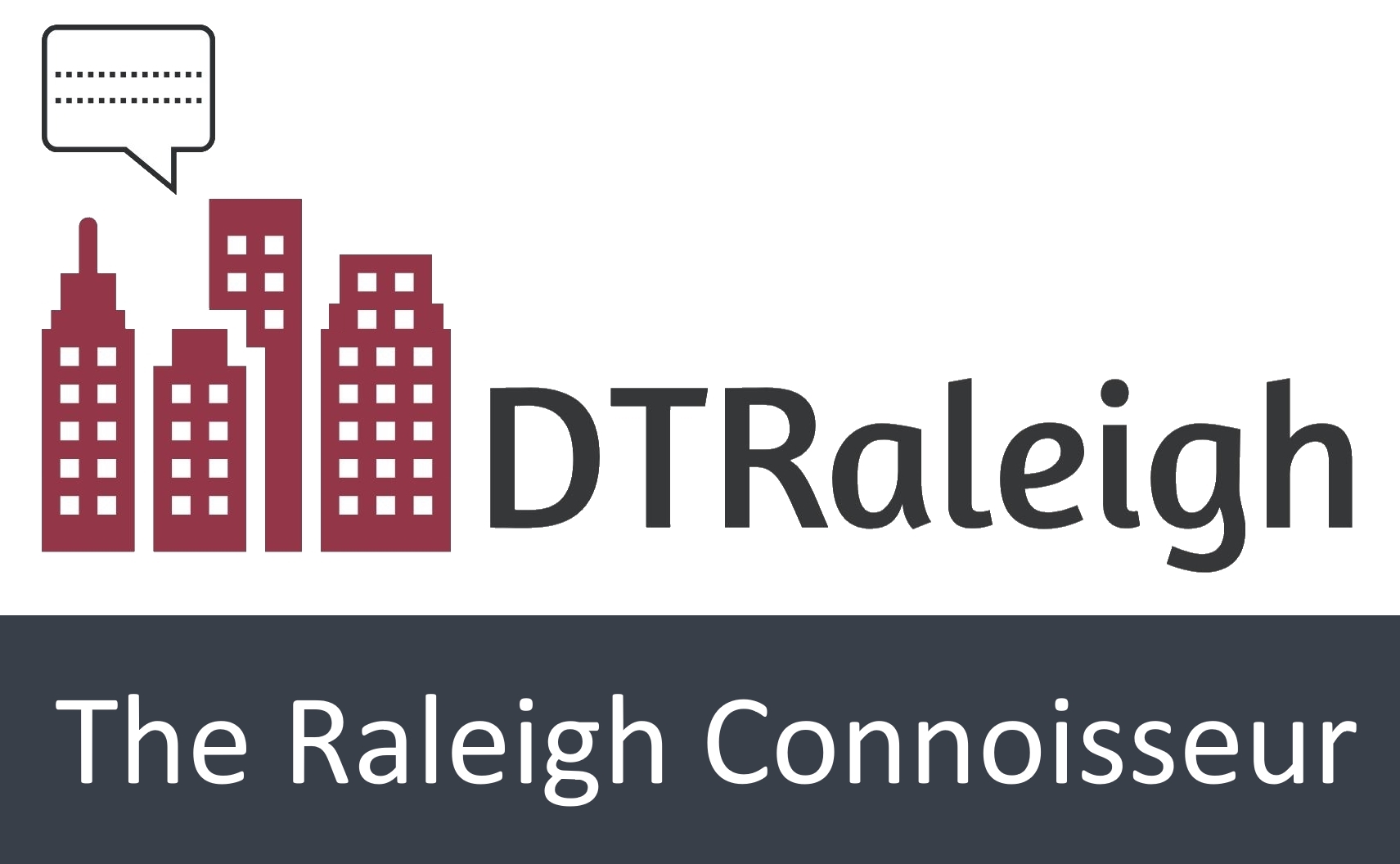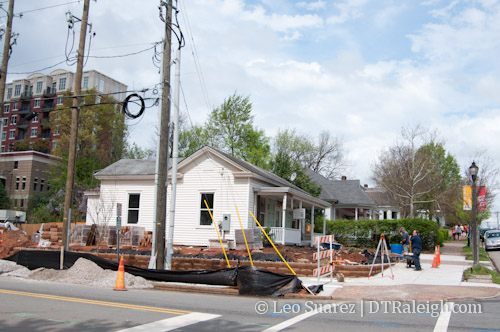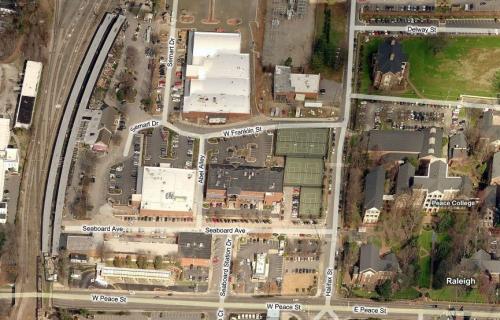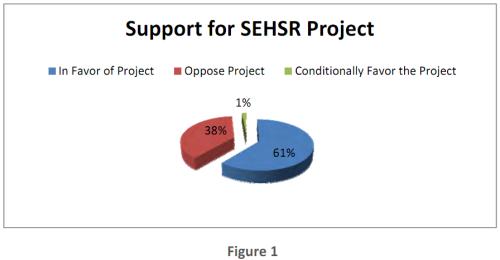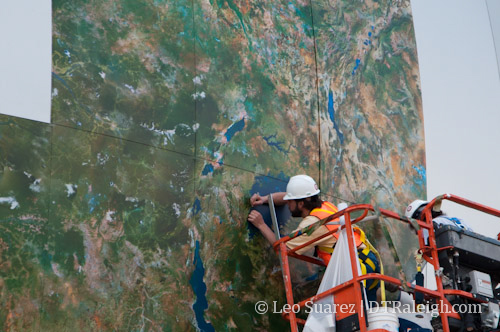
Workers cover the globe, called The Daily Planet, of the Nature Research Center (NRC) with the continents of the Earth. The NRC opens with a big party starting on April 20th.
Renovations For Libations in Glenwood South
Approved back in December 2011, the house in the picture above, located at 603 Glenwood Avenue, is being heavily renovated for a new bar with outdoor seating. While passing by I asked some of the gentlemen working on the renovations about the new bar. They mentioned that this was being done by the owner of 606, the club across the street, and that the bar would be styled like a speakeasy.
Another thing to note about the picture is that you can see the comprehensive plan in action. Look at those wide sidewalks!
The State of Seaboard Station
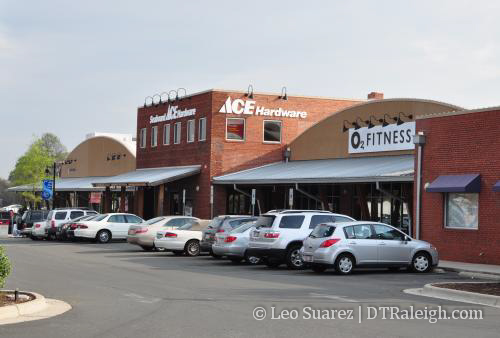
Seaboard Station sits at the northern end of downtown Raleigh and is a unique area compared to Glenwood South or Fayetteville Street. Over the last few years, the area seems to be riding with the downtown revitalization wave but there’s just something that’s holding it back. Why don’t people come to Seaboard and stay for awhile? I’ve always felt like the area was convenient for quickly getting there, but just the same, easy enough to get right out.
The Shops at Seaboard Station website plays on the locally owned theme of restaurants and services. 18 Seaboard and J. Betski’s have been serving at Seaboard for a few years now and the recently opened Tyler’s Taproom seems to be an instant favorite. While not included on their website, Sunflower’s needs a big nod for doing business here for almost thirty years.
In retail, Seaboard is creating a little variety for shoppers. Logan Trading Co. may be the anchor tenant and the family-owned garden shop has been open since 1991. Over the last few years, places like Seaboard Wine, Ace Hardware, and O2 Fitness have moved in to diversify the list of services.
But the most dramatic story in recent history may be what happened in 2007. A grocery store, Capital City Grocery, opened in Seaboard Station with high anticipation. The news was all over it, saying it was the pinnacle of downtown Raleigh’s re-birth. However, over time the hype died down and reviews were mixed about the store. For whatever reason, the grocery store closed and re-opened in 2008, only to close permanently later that year.
Around that same time, condo projects were even planned for Seaboard Station. The 111 Seaboard condos were planned along Seaboard Avenue but that project never came to be. Now, the empty building will not be razed for development but renovated for more retail spaces.
Today, Seaboard Station has a few new tenants in addition to the previously mentioned with plenty of empty space for more.
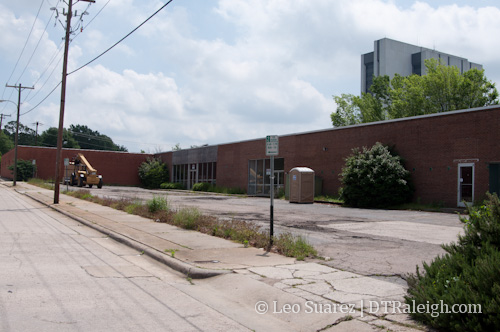
Empty Storefronts at Seaboard Station
The events, the largest probably being the Music on the Porch series during the warmer months, have been fine but what will it take for Seaboard Station to naturally be a hub of activity?
The area has some natural obstacles all around it. To the south, the black hole that is the state government complex will almost never contribute more than a steady lunch crowd. The customer base to the east is not growing much with Peace College and the Mordecai and Oakwood neighborhoods. The area is also cut off somewhat with the train tracks to the north and Capital Blvd to the west. The area is somewhat isolated.
Seaboard’s contribution to downtown is not urban at all so its suburban nature makes it compete with other places of similar style. The vast parking lots make it easier for cars to go in and out so it is now competing with other shopping centers around the city. If I have to drive to Seaboard Station, then why choose that area if getting to someplace better outside of downtown is just as easy now that I’ve made the decision to drive? You can see it in the map below.
In my opinion, Seaboard Station cannot do it alone and needs to be tied into a few other projects in order for it to be a place to stay awhile. The Blount Street Commons project that essentially stalled when the economy went bad a few years ago needs to be re-energized in some way. More residents need to move into the northern end of downtown to feed Seaboard. The Capital Blvd Corridor study will also be a huge factor in realizing Seaboard’s potential. This study also includes a Peace Street corridor redesign which could greatly improve Peace Street.
The location is great but the barriers are too restrictive at the moment for Seaboard Station. The current stop on the R-Line is another plus but even greater connectivity is needed for this area to feel like an integral part of downtown Raleigh.
Municipography, Walking, Union Station, and Commuter Trains
Municipography is a summary of current issues going through the Raleigh City Council and other municipal departments in the city. The point is to try to deliver any video, photos, and text associated with the discussions happening at City Hall or elsewhere. Since this is a downtown Raleigh blog, the focus is on the center of the city.
Walk Raleigh
Matt Tomasulo and his Walk Raleigh signs have been accepted as a gift to the city. The signs brought international attention to Raleigh and after some time had to be taken down because of the lack of a permit. Still, the signs made their statement and some will be put back up for a 90 day pilot program.
The council unanimously approved.
Union Station Financials
Last month, city staff was authorized to apply for a Transportation Investment Generating Economic
Recovery (“TIGER”) grant for a component of Union Station. The NCDOT and Triangle Transit are helping with the application too and have come up with this financial breakdown:
- Station development: 80% federal, 10% state, 10% city
- Rail/track/platform improvements: 80% federal, 20% state
- Street improvements: 80% federal, 20% city
This puts the city’s cost at $7 million. Remember, that last year $3 million was approved by voters in the Transportation Bond. So the remaining $4 million will have to be worked into next year’s budget cycle. This move helps the grant application.
John Odom voted against this stating concerns about the cost while the rest of the council approved.
Commuter Rail Station Locations
The city’s Passenger Rail Task Force stopped by to endorse the locations of the commuter rail stations in Raleigh. Those four being at:
- Southeast Raleigh at Hammond and Rush Streets
- Downtown Raleigh at the Warehouse District
- NC State near Dan Allen Drive
- West Raleigh near Corporate Center Drive
You can read about more about this as well as light rail and buses at the Transit tag link but for the best wrap up of the commuter rail plans jump to, “Transit, Commuter Rail, and More, We Dive Into The Docs.”
The council approved this unanimously.
Pic of the Week
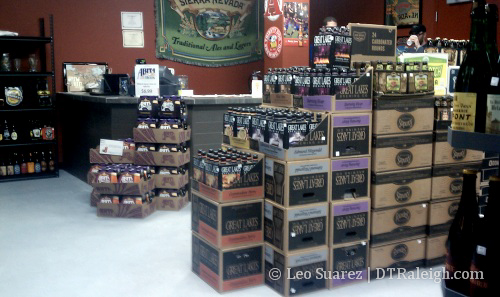
More beer choices for downtowners. The bottle shop is located near the speakeasy entrance of Tyler’s Taproom, near the rear of the main Seaboard Station building alongside 18 Seaboard.
The Bottle Shop at Tyler’s Taproom
- Mon – Thu: 10:00 am-10:00 pm
- Fri – Sat: 10:00 am-10:30 pm
- Sun: 12:00 pm-8:00 pm
Pic of the Week
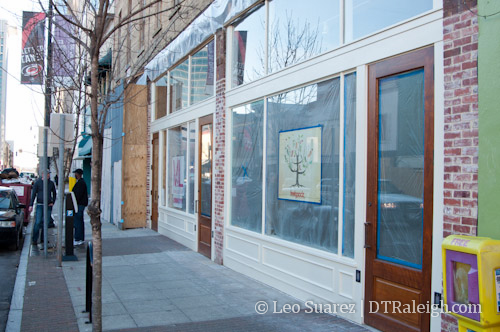
Renovated retail spaces popping up on Wilmington Street. One will be a flip-flop shop, Feelgoodz, and the other a jewelry store, Moon & Lola.
A Visit To The North Carolina Museum of History
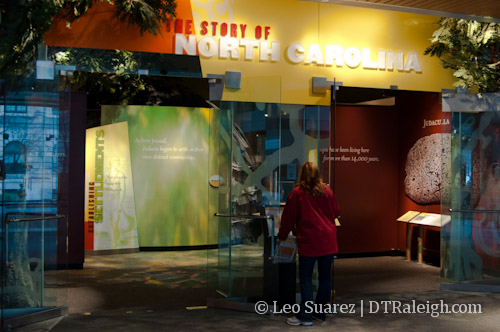
Even with the random warmer days this winter, the cold ones we are getting have kept me indoors. The recent cold rains ran me into the North Carolina Museum of History to check out the newest exhibit, “The Story of North Carolina.” I read about its opening back in November and have finally made it over to see it. The new exhibit challenges history buffs and can entertain everyone else.
Plenty of North Carolina’s history is represented from all areas of the state. As you walk through the exhibit, you are walking through a timeline that starts around 14,000 years ago. The museum website describes it best as:
More than 14,000 years of the state’s history unfold through fascinating artifacts, multimedia presentations, dioramas, and hands-on interactive components. Additionally, two full-size historic houses and several re-created environments immerse museum visitors in places where North Carolinians have lived and worked. Yet the heart of The Story of North Carolina focuses on the people — both well-known and everyday citizens — who shaped the Tar Heel State.
The two houses, one being the state’s fourth oldest, offer a glimpse into the past as they are furnished in a way to represent how they could have looked at a certain period in time.
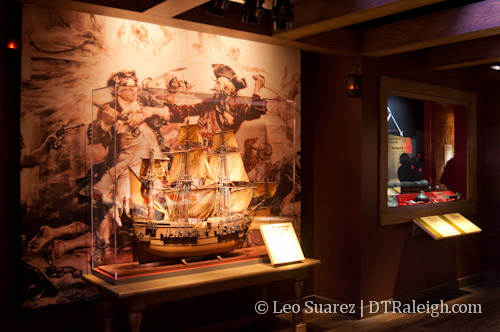
The models are detailed, the visuals are impressive, and there is enough audio and visual information to keep anyone interested. I liked hunting for random facts such as the fact that the nation’s first gold cold was minted in North Carolina in the 1830s. Back then, the state had $1, $2.50 and $5 gold coins as well.

For the readers here in Raleigh, there is plenty of events that took place here in the capital. I recommend a visit sometime this winter if you’re ever stuck without plans on a dreary day.
Hey, it’s also free.
The North Carolina Museum of History
(http://ncmuseumofhistory.org/)
5 East Edenton St., Raleigh, N.C.
Open Monday-Saturday, 9 a.m. to 5 p.m.
Sunday, Noon to 5 p.m.
There are also a few more photos on Facebook.
North Carolina and Virginia States Pick Preferred Alternatives For High-Speed Rail
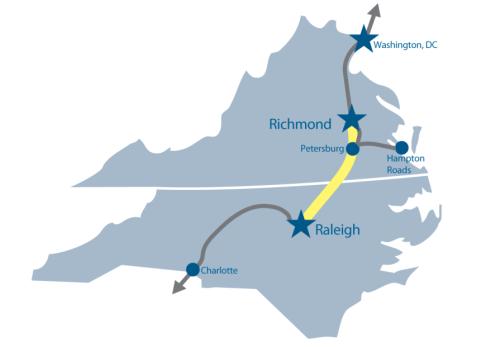
First, let’s start off with the city’s press release:
The North Carolina Department of Transportation (NCDOT) and the Virginia Department of Rail and Public Transportation (DRPT) have released a report recommending to the Federal Railroad Administration (FRA) the preferred rail alternative for each of the 26 sections of the Southeast High Speed Rail (SEHSR) corridor between Richmond, Va. and Raleigh, N.C. (R2R).
The report alternatives are based on considerations concerning the human and natural environment, costs, and operability/constructability. Also considered were the public, local government, and agency comments received following the May 2010 publication of the SEHSR Tier II Draft Environmental Impact Statement (DEIS) for the R2R portion of the SEHSR. Eight public hearings were held in July 2010 to provide information on the alternatives and obtain public input, and several alternatives have been redesigned based on comments received from the public.
Once approved by FRA, the preferred alternatives will be presented in the forthcoming Tier II Final Environmental Impact Statement (FEIS), anticipated to be published in early 2013, followed by a Record of Decision from the FRA and a second round of public hearings.
The SEHSR project proposes to implement approximately 162 miles of high speed rail as part of an overall plan to extend high speed passenger rail service from the Northeast Corridor (Boston, Mass. to Washington, D.C.) southward through Virginia to Charlotte, N.C. and Florida.
The Recommendation Report is available for download on the project website www.sehsr.org.
A lengthy process but another milestone achieved in this plan to better connect North Carolina’s cities to Richmond and points north. For more posts about the Southeast High-Speed Rail project and how it relates to downtown Raleigh, dive into the archives tagged SEHSR.
Looking at the draft recommendation report, there are sections that go over the public hearings that took place starting in 2010 as well as an overview of the comments received. I pulled two of the charts from the report and have them below.
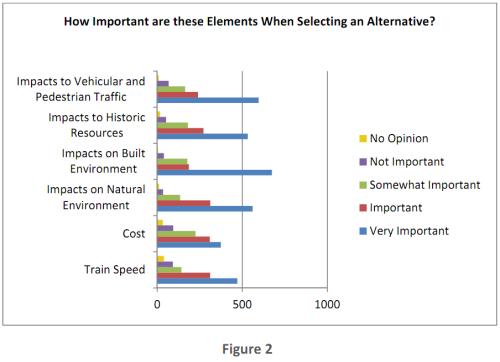
Click on the graphics for a larger view.
There are a couple of interesting points in the second figure. The exact numbers aren’t provided so based on the graph we have:
- The two most important issues to respondents, that is combining the “Important” and “Very Important” response, were Impacts on Built Environment and Impacts on Natural Environment.
- Cost appears to be the least most important element, getting the most “Not Important” responses.
Without deeper surveys, the results can be interpreted in different ways so take it for what it’s worth.
Continuing through, the document then explores each of the twenty-six sections of the route with an overview of alternatives and the final pick of the preferred route for this section. The North Raleigh to Downtown Raleigh piece is the last section mentioned, section V.
The report recommends the NC5 Alternative. We’ve analyzed the NC5 plan back in September 2011 when it was announced. From the document:
The recommended preferred alternative in Section V is Alternative NC5. This decision is based on the fact that it minimizes impacts to neighborhoods, freight operations, and historic resources, and was endorsed by the Raleigh City Council on October 4, 2011. Exhibit 56 shows that NC5 has the least impacts to streams, no residential relocations, fewer business relocations compared to NC3 (but greater than NC1 and NC2), and only one severely impacted noise receptor (compared to 40 for the other alternatives). Additionally, apart from the impact to the historic Raleigh and Gaston Railroad Corridor that is common among all alternatives, Alternative NC5 has no additional impacts to historic resources. Each of the other alternatives (NC1, NC2, and NC3) would have an adverse effect on at least one resource protected under Section 106 of the NHPA, and also require a Section 4(f) use of those properties.
NC5 is also favored by the public. Following the Project Update Meeting, 61 comments were submitted by the public expressing preference for an alternative: three were in favor of NC1 (with no specific reason stated); three were in favor of NC2 (based partially upon cost considerations); three were in favor of NC3 (based upon rail designs, interaction with freight railroads, and downtown connectivity); while 52 expressed a preference for NC5 (based primarily upon minimized impacts to neighborhoods, freight operations, and historic resources).
To see the figures and maps, as well as information on each section, download the report.
